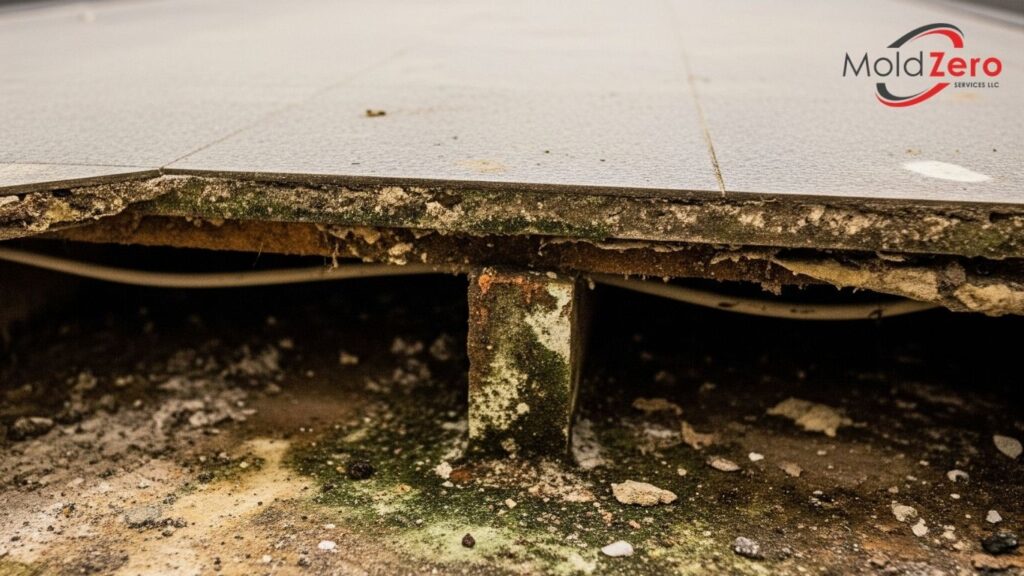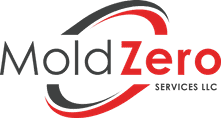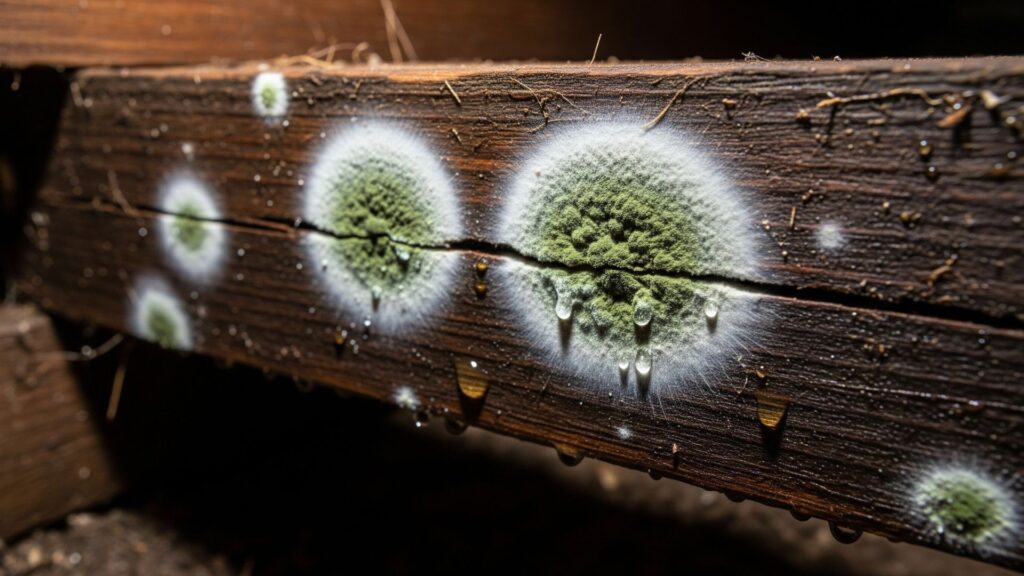Trichoderma Mold: A Comprehensive Guide for Homeowners
Discovering mold in your Los Angeles home or business is unsettling. When you see a patch of white, green, or gray growth, especially on water-damaged materials, you could be looking at Trichoderma. This type of mold is a common invader of indoor environments with moisture problems.
As NORMI Certified professionals who have completed over 1,000 mold remediation jobs, we at Mold Zero understand the specific challenges Trichoderma presents. It’s known for its rapid growth and its ability to digest building materials, making a swift and professional response essential.
This guide will walk you through what property owners need to know about this mold and why addressing it properly is critical for the well-being of your property and its occupants. If you suspect you have a Trichoderma issue, don’t wait. Contact Mold Zero for a free, no-obligation inspection.
What is Trichoderma Mold?
Trichoderma is a genus of fungi commonly found in soil, decaying plant matter, and wood. While it plays a vital role in outdoor ecosystems, it becomes a significant problem when it establishes itself inside your property. It thrives in environments with high humidity and is frequently found on materials with high cellulose content that have been saturated with water, such as drywall, wallpaper, wood, and carpet.
One of its most notable characteristics is its aggressive nature. It is often a fast-growing indoor mold, capable of quickly colonizing a damp area. Its presence is a clear indicator of a persistent moisture problem that must be addressed to resolve the mold issue at its source.
Why Professional Assessment is Crucial
While you might be able to spot discoloration, a professional assessment is key. Different types of mold can appear similar, and only an experienced technician can properly evaluate the extent of the growth, identify the moisture source, and develop an effective remediation plan. At Mold Zero, our experienced inspectors provide a thorough evaluation to give you a clear picture of the situation. We believe in empowering property owners with accurate information so they can make the best decision for their property.
A quick call to (626) 671-8885 can get our team on-site for a comprehensive inspection, which is the first step toward a lasting solution.
Identifying Trichoderma in Your Property
Proper identification is the first step toward addressing a mold problem. Trichoderma often appears in woolly patches that start as white or off-white and mature into a distinct green or gray-green color. This appearance is why it’s often referred to as Trichoderma green mold. Because it can grow alongside other molds, the coloration can sometimes be mixed, making a definitive visual identification challenging for an untrained eye.
However, its typical appearance and preferred locations can give you strong clues that you’re dealing with this specific type of mold.
Common Appearance and Growth Patterns
- Color Progression: Initially, colonies are often dense and white. As they mature and produce spores, they typically turn a shade of green, from pale green to a deep forest green. This is a classic sign of Trichoderma.
- Texture: The texture is often described as woolly or cottony, forming compact tufts that can spread outward rapidly across a surface.
- Rapid Growth: Trichoderma is known as a fast-growing indoor mold. In ideal conditions—meaning high moisture and a food source—it can become visible in a very short amount of time, sometimes appearing to grow overnight on a wet surface.
Where to Look for Trichoderma
Trichoderma requires significant moisture to thrive. Therefore, you are most likely to find it in areas of your property that have experienced water damage or have consistently high humidity. Be sure to check these common locations:
- Water-Damaged Building Materials: Drywall, insulation, and particleboard that have been soaked from a leak or flood are prime targets. You may see the characteristic white-green mold on wood surfaces, especially subflooring or framing that has been exposed to moisture.
- Basements and Crawl Spaces: These below-grade areas are prone to dampness, condensation, and water intrusion, creating a perfect environment for Trichoderma to grow on wooden support structures and stored items.
- HVAC Systems and Ductwork: Condensation within an HVAC system can lead to mold growth on filters, coils, and inside ductwork, which can then circulate spores throughout the property.
- Carpets and Fabrics: If a carpet has been wet for an extended period due to a spill or flood, Trichoderma can grow on the carpet itself and the underlying padding and subfloor.
The Impact of Trichoderma on Your Property’s Structure
Beyond its appearance, the primary concern for property owners is the physical damage Trichoderma can cause. This mold is particularly aggressive toward cellulose-based materials, which make up a significant portion of a building’s structure. Its ability to digest these materials can lead to serious and costly structural issues if not addressed promptly and professionally. This is not just a surface stain; it’s an active process of decay.
Mold Destroying Wooden Beams and Structures
Trichoderma produces enzymes that break down cellulose, hemicellulose, and lignin—the primary components of wood. This digestive process weakens the wood from the inside out. When you see white-green mold on wood, especially on structural components like floor joists, roof trusses, or wall studs, it’s a major red flag.
This process of decay can compromise the structural integrity of your property over time. What might start as a small patch of mold on a damp beam can, if left unchecked, lead to wood rot, reducing the load-bearing capacity of the structure. This is why we stress the urgency of addressing any signs of mold on wooden beams immediately.
Damage to Other Building Materials
Wood is not the only material at risk. Trichoderma can also severely damage other common building materials, leading to a range of problems:
- Drywall and Plaster: The paper facing on drywall is a rich source of cellulose. Trichoderma can quickly colonize and disintegrate it, causing it to become soft, crumble, and require complete replacement.
- Insulation: Fiberglass insulation can trap moisture and organic dust, while cellulose insulation is a direct food source. Mold growth within insulation renders it ineffective and necessitates its removal.
- Flooring and Ceilings: Mold can destroy carpets, delaminate composite flooring, and cause ceiling tiles to sag and collapse. The damage often extends beyond the visible surface to the subfloor and support structures above.
The cost of repairing this structural damage often far exceeds the cost of professional mold remediation. By calling Mold Zero at (626) 671-8885 for a free inspection at the first sign of trouble, you can prevent minor water damage from escalating into a major structural repair project.

Concerns About Trichoderma and Occupant Well-being
As property owners, the well-being of family, tenants, or employees is a top priority. When mold like Trichoderma is present, it can release large quantities of spores and volatile organic compounds (VOCs) into the air, which can affect the indoor environment.
While we avoid making specific health claims, it’s widely understood that living or working in a property with a significant mold issue is not ideal. Certain individuals may be more sensitive to the presence of mold spores in their environment.
Understanding Potential Trichoderma Allergy Symptoms
For some people, exposure to elevated concentrations of mold spores can lead to allergic-type reactions. If you or others in your property begin experiencing new or worsening symptoms that seem to improve when you leave the building, it could be related to the indoor environment. Common Trichoderma allergy symptoms can include:
- Persistent coughing and sneezing
- Watery or itchy eyes
- Nasal congestion or a runny nose
- Irritation of the throat
- Skin rashes or irritation
These sensitivities can be particularly pronounced in individuals with pre-existing respiratory conditions or compromised immune systems. Our “Family First” philosophy at Mold Zero means we use solutions and processes we would trust in our own homes, focusing on restoring a quality indoor environment for everyone.
Trichoderma longibrachiatum and Other Species
The Trichoderma genus includes many different species, one of the most frequently identified in water-damaged buildings being Trichoderma longibrachiatum. This species, like others in its genus, is known for its aggressive growth and spore production.
The specific species present doesn’t change the fundamental need for remediation. The presence of any visible mold growth, regardless of the species, indicates a moisture problem that needs to be fixed and a contamination issue that needs to be professionally addressed. Attempting to guess the species or its potential effects is not a substitute for a comprehensive remediation plan.
Why DIY Methods Fail for Removing Trichoderma
When faced with a mold problem, the temptation to try a DIY solution is understandable. However, when dealing with an aggressive mold like Trichoderma, these methods are often ineffective and can even make the situation worse. Understanding the limitations of DIY approaches is key to realizing why a professional service is the superior choice for a lasting solution.
The Challenge of Removing Trichoderma from Wet Surfaces
Trichoderma embeds itself deep within porous materials. Simply spraying a bleach solution or store-bought cleaner on the surface does very little. Here’s why DIY fails:
- Surface-Level Cleaning: Bleach may discolor the visible mold on the surface, making you think the problem is solved. However, it does not penetrate porous materials like wood or drywall to address the mold’s root structure (mycelium). The mold will inevitably grow back.
- Spore Dispersal: Scrubbing or disturbing a Trichoderma colony without proper containment measures can release millions of spores into the air. These spores can then travel through your HVAC system and land on other damp surfaces, creating new colonies and spreading the problem throughout your property.
- Failure to Address Moisture: The most critical failure of DIY methods is that they don’t address the underlying moisture source. Unless the leak, condensation, or humidity issue is properly identified and repaired, the mold will always return.
Our NORMI Certified professionals at Mold Zero have the training, equipment, and experience from over 1,000 jobs to handle Trichoderma correctly. We establish proper containment and use specialized techniques to address the mold without spreading it, ensuring a comprehensive resolution.
Mold Zero’s Guaranteed Process for Trichoderma Remediation
At Mold Zero, we have developed a unique 5-step process that is fast, minimally invasive, and highly effective at addressing Trichoderma and other mold issues in Los Angeles and San Marino properties. Our approach is designed to resolve the problem thoroughly while minimizing disruption to your life. We complete most jobs in just hours, not days, and back our work with a 1-year guarantee.
Step 1: Comprehensive Inspection and Assessment
Our process begins when you call us at (626) 671-8885. We conduct a free, detailed inspection to identify the type of mold, the extent of the growth, and, most importantly, the moisture source fueling the problem. This allows us to create a precise and targeted remediation plan.
Step 2: Containment of Affected Areas
Before any treatment begins, we establish critical containment barriers. This involves sealing off the work area from the rest of your property using plastic sheeting and negative air pressure. This crucial step prevents any particulates or spores from migrating to unaffected areas during the remediation process, protecting the integrity of your indoor environment.
Step 3: Addressing the Mold at its Source
With containment in place, our technicians apply our advanced solution that neutralizes mold on contact. Our process is highly effective on a wide range of surfaces, including drywall, wood, and concrete. We meticulously treat all affected areas, ensuring we address the mold at its source to resolve the immediate problem.
Step 4: Application of Our Protective Solution
After addressing the existing mold, we apply a second, proprietary solution. This application is designed to create an environment where new mold growth is discouraged. It’s a crucial part of our process that allows us to stand behind our work with a 1-year guarantee, giving you lasting peace of mind.
Step 5: Third-Party Lab Verification
This is where Mold Zero truly stands apart. We don’t just tell you the job is done; we prove it. After our work is complete, we arrange for an independent, third-party lab to conduct post-remediation air and surface testing. This provides you with unbiased, scientific proof that the mold issue has been successfully resolved to industry standards. This verification is your ultimate peace of mind.
Take Action Against Trichoderma in Your Los Angeles Property
The discovery of Trichoderma mold, especially white-green mold on wood or near structural beams, demands immediate attention. The longer you wait, the more extensive the potential damage to your property can become. Don’t risk the structural integrity of your home or business, and don’t settle for incomplete DIY methods. Choose the proven, guaranteed, and verified process from the experts at Mold Zero.
Contact Us Today for a Free Inspection
Protect your property and the well-being of its occupants. Our team of NORMI Certified professionals is ready to provide a fast and effective solution for your mold concerns in Los Angeles, San Marino, and the surrounding areas. We have successfully completed over 1,000 remediation jobs, and we are ready to help you.
- Call Us Now: Speak directly with a specialist by calling (626) 671-8885. We can answer your questions and schedule your free inspection immediately.
- Fill Out Our Form: Prefer to write? Complete the online contact form on our website, and one of our experts will get back to you promptly to arrange your no-obligation quote.

